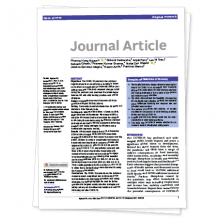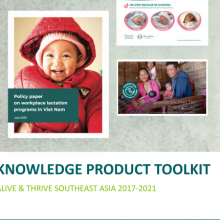Journal article
Jan 13 2023

Differences in the Microbiological Profile of Raw and Pasteurized Breastmilk from Hospital and Community-Based Donors at the First Human Milk Bank in Vietnam (Tran HT, Nguyen TT, et al, Nutrients. 2023)
Microbiological quality is one of the key safety standards in human milk bank operations.
Journal article
Dec 08 2022

Impacts of a social and behavior change communication program implemented at scale on infant and young feeding practices in Nigeria: Results of a cluster-randomized evaluation (Flax VL, Fagbemi M, et al. PLOS One. 2022)
The objective of this study was to measure the impact of Alive & Thrive’s IYCF social and behavior change communication intervention on early initiation of breastfeeding, exclusive breastfeeding, and minimum dietary diversity in Kaduna and Lagos States.
Journal article
Jul 27 2022

Disruptions, restorations and adaptations to health and nutrition service delivery in multiple states across India over the course of the COVID-19 pandemic in 2020: An observational study
This article details the results of Alive & Thrive's study of disruptions and restorations, challenges and adaptations in health and nutrition service delivery by frontline workers in India during COVID-19 in 2020.
Toolkit
Jun 28 2022

Southeast Asia Knowledge Product Toolkit
This toolkit introduces and disseminates knowledge products from A&T's key interventions and impact in Southeast Asia from 2017-2021 under 3 key program objectives:
Journal article
Jun 17 2022

Complementary feeding social and behavior change communication for fathers and mothers improves children's consumption of fish and eggs and minimum meal frequency in Kaduna State, Nigeria (Flax, V. Current Developments in Nutrition. 2022)
This study measured the effects of a multipronged 12-month intervention in Kaduna State that targeted complementary feeding (CF) social and behavior change communications to both fathers and mothers, showing improvements in parents’ CF practices and knowledge, as well as fathers’ support for CF.&
Journal article
Jun 14 2022

Behavior Change Communication Implemented at Scale in Nigeria Increases the Prevalence of Key Infant and Young Child Feeding Practices (Current Developments in Nutrition, 2022)
This study evaluated the impact of Alive & Thrive Nigeria's IYCF behavior change communication activities (e.g., interpersonal communication in health facilities, community mobilization, and mass media) on early initiation of breastfeeding, exclusive breastfeeding, and minimum dietary diversity.

